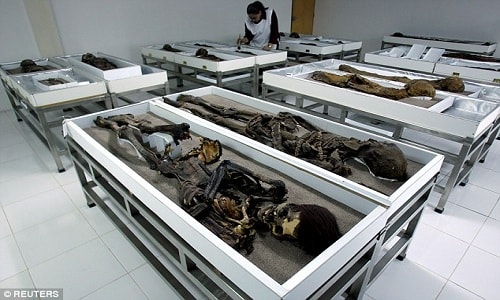The world's oldest mummy is at risk of decomposition.
Ancient mummies buried more than 7,000 years ago in the arid desert of northern Chile are turning to black slime under the effects of climate change.
 |
| Mummies in the San Miguel Museum in Arica, Chile. Photo: Reuters. |
Chilean researchers have discovered that high humidity can lead to an explosion of bacteria living on the skin of 7,000-year-old Chinchorro mummies, Reuters reported yesterday. They are working on ways to prevent decomposition and protect the world's oldest collection of mummies, housed at the archaeological museum of the University of Tarapaca in Chile.
The Chinchorro were a prehistoric people who lived in scattered communities and fished for a living in the coastal deserts of Chile and Peru. They preserved their dead by mummifying them as a religious practice, creating a bridge between the worlds of the living and the dead. About 282 mummies have been found under the arid sands of the region, but scientists believe there are hundreds more buried underground.
Some Chinchorro mummies predate Egyptian mummies by nearly 4,000 years. The oldest mummy discovered in the Antacama Desert was buried in 7020 BC, while the oldest Egyptian mummy dates to 3,000 BC.
"We dated the mummies to 7,000 years ago. So they are relatively old compared to mummies found in Egypt," said Sergio Medina Parra, an anthropologist at the University of Tarapaca.
Arica and the surrounding Atacama Desert are among the driest places on earth. Rainfall is less than 0.05 cm a year. The year-round dry climate has helped preserve mummies for 7,000 years. However, the area is increasinglybecomehumidity due to climate change in recent years.
Scientists at the University of Tarapaca Museum first noticed black, slimy patches appearing on the skin of Chinchorro mummies about 10 years ago. Over time, the mummies deteriorated at an alarming rate as their skin decomposed into a black slime.
A team of researchers at the Harvard School of Engineering and Applied Sciences in the US conducted a series of tests to find out the causes of the deterioration of mummies. They found that bacteria that grow on human skin thrive on mummies with high humidity. According to the test results, mummies need to be preserved in an environment with 40-60% humidity to prevent further deterioration.
According to VNE
| RELATED NEWS |
|---|
